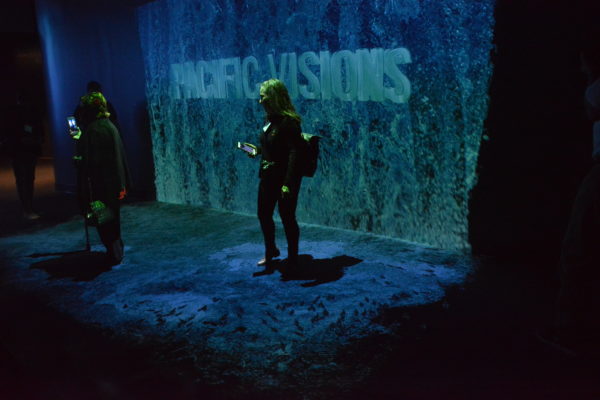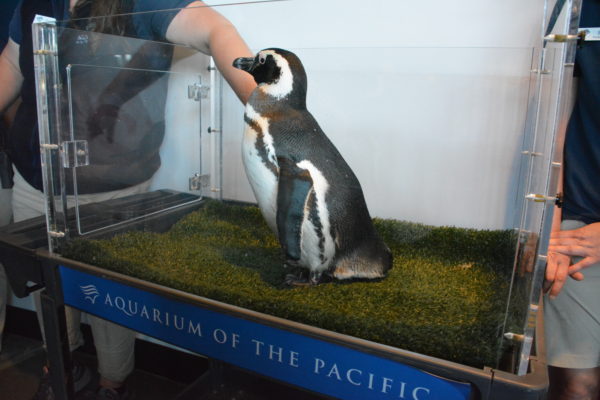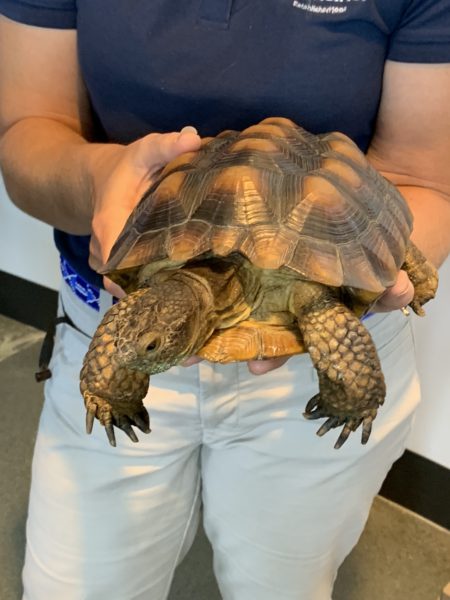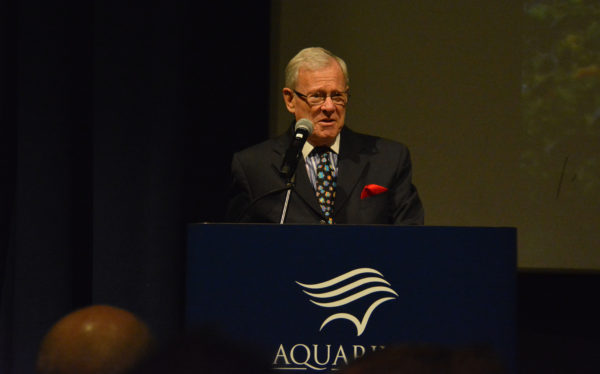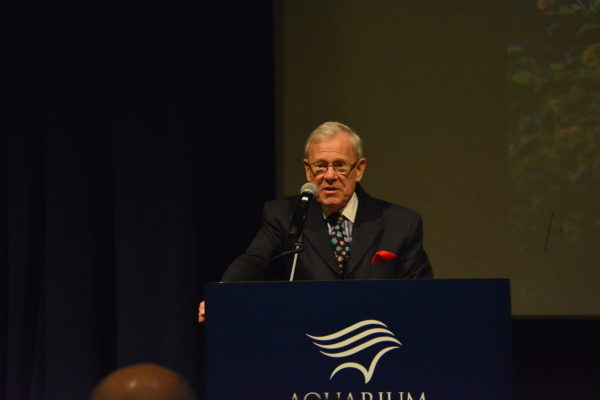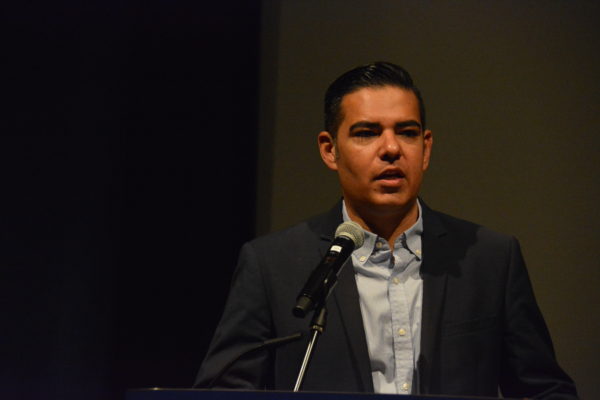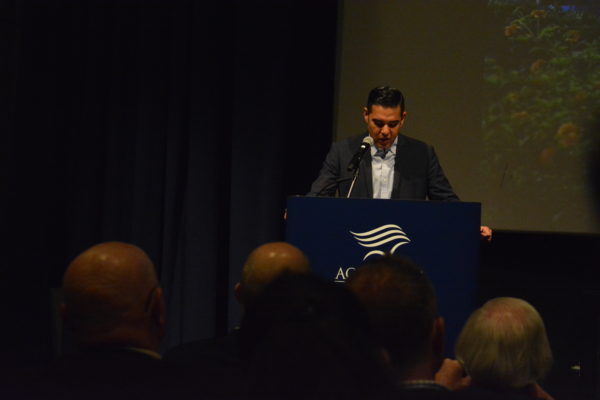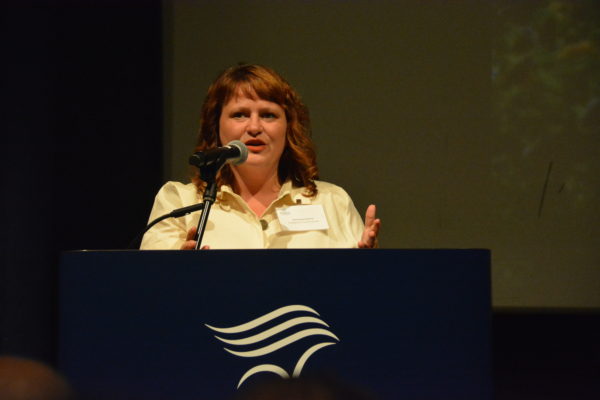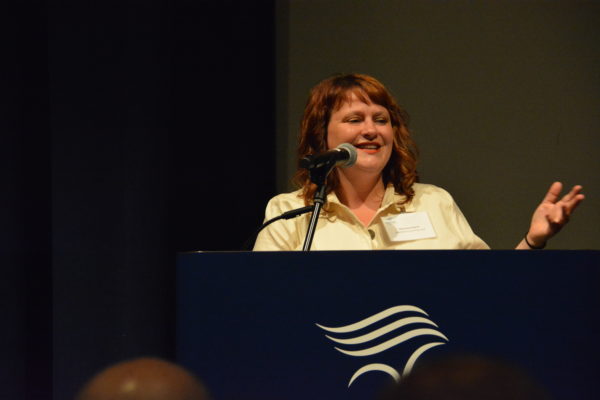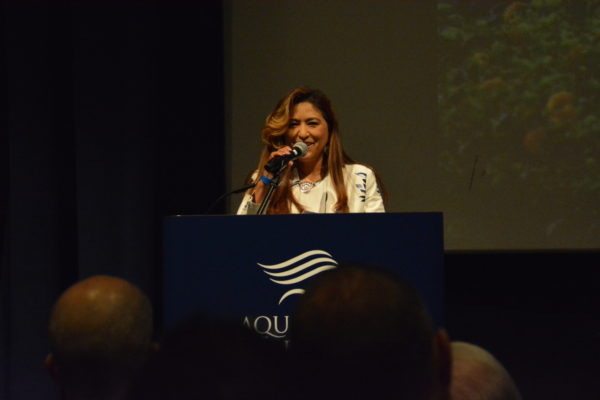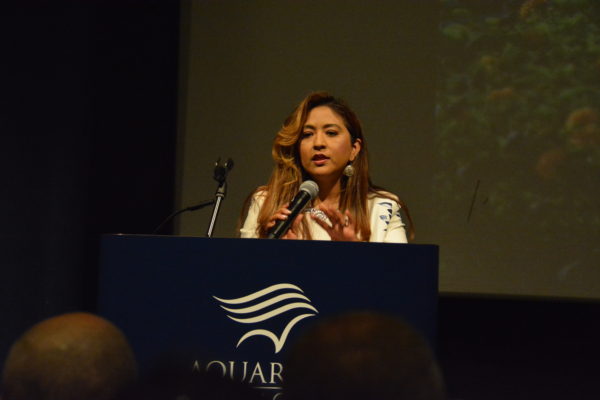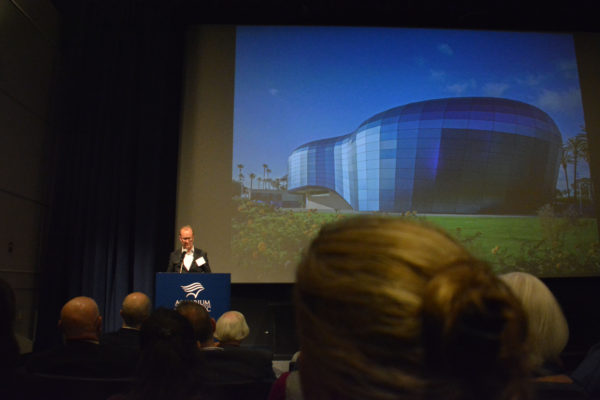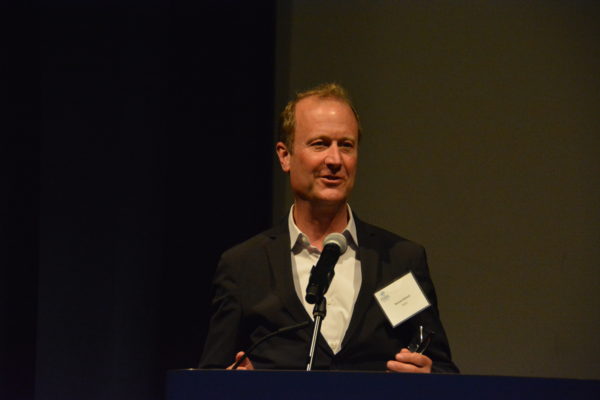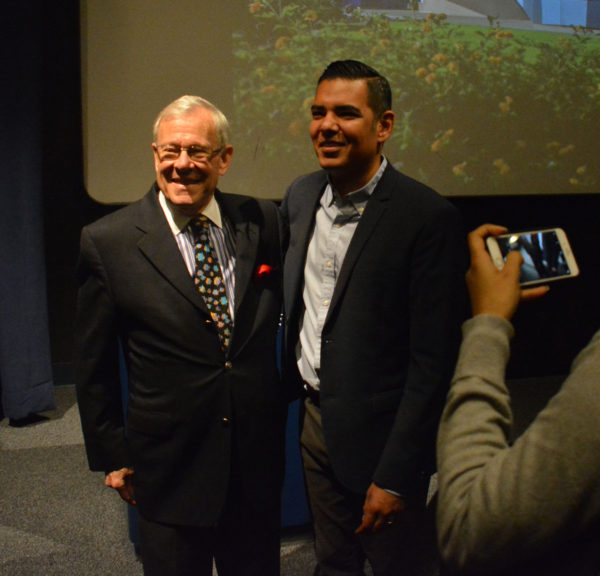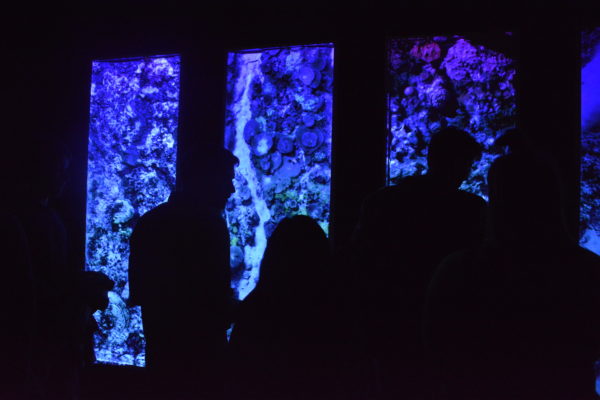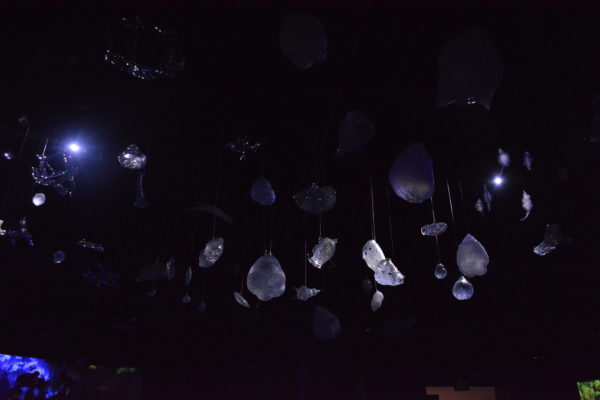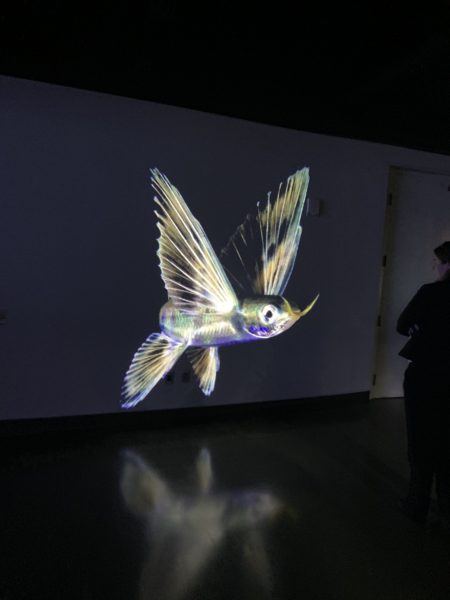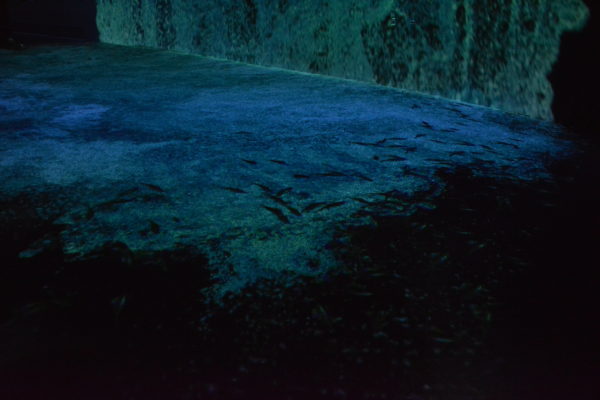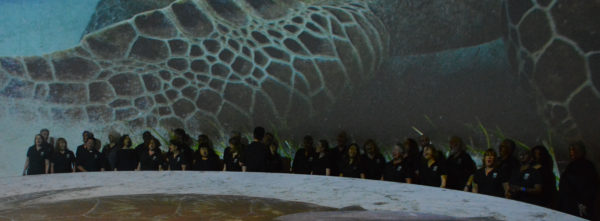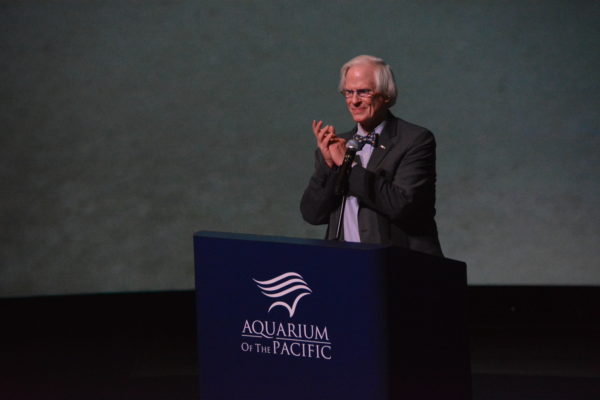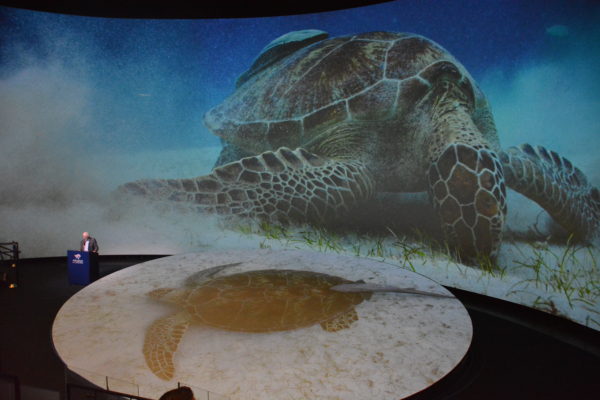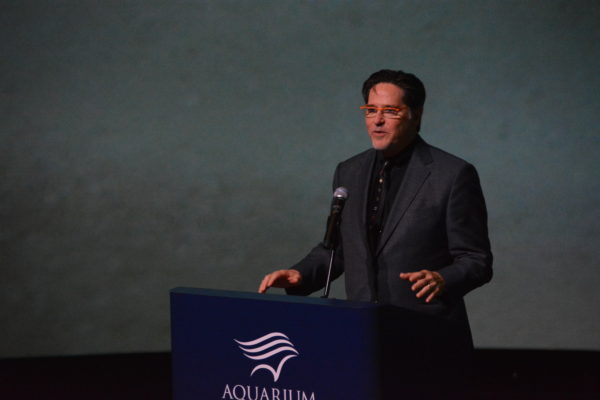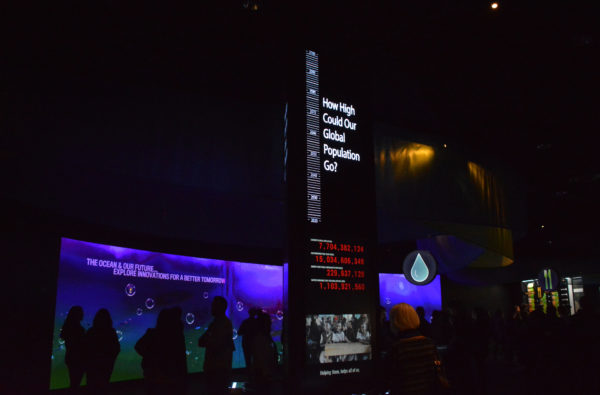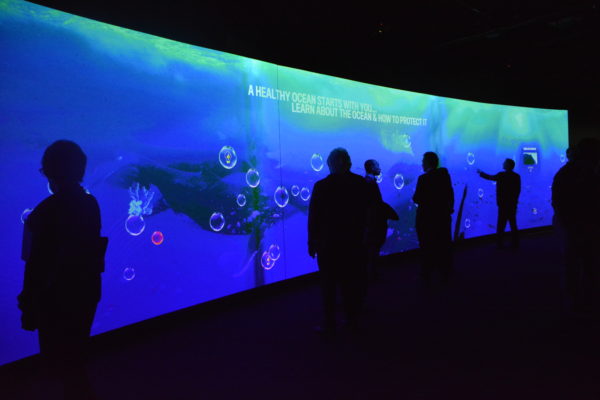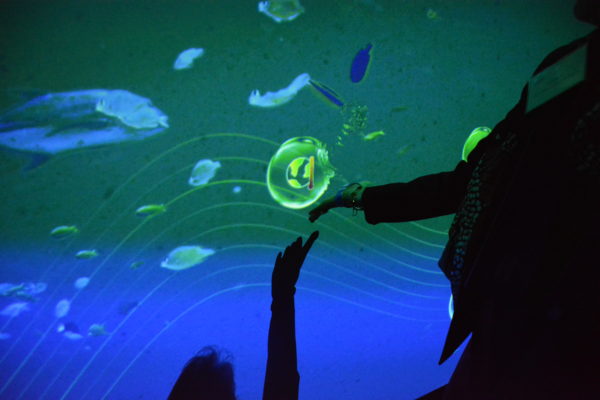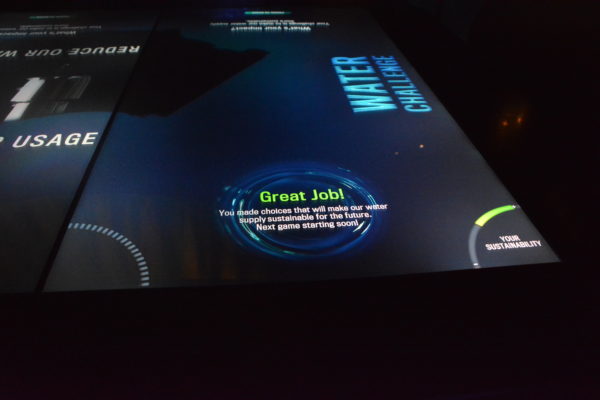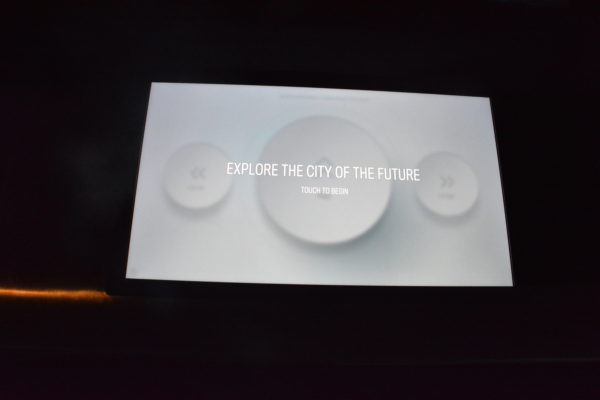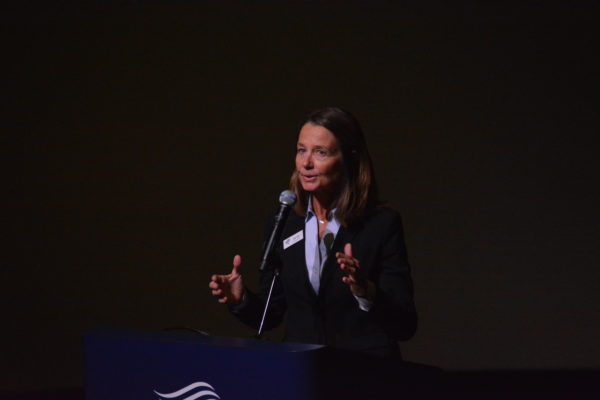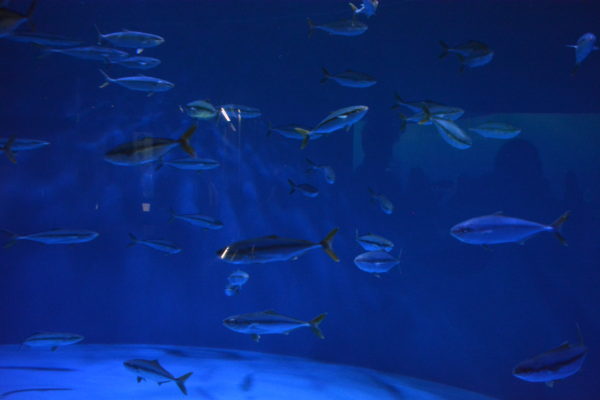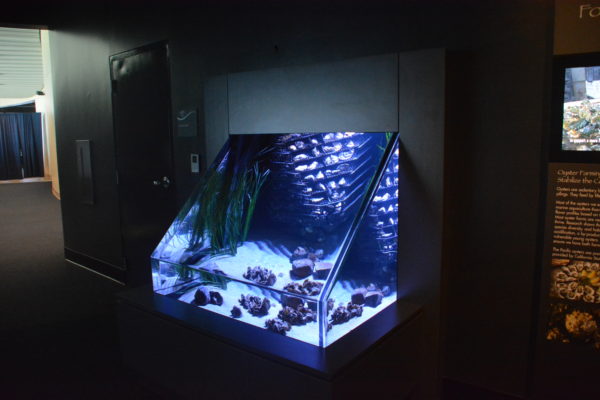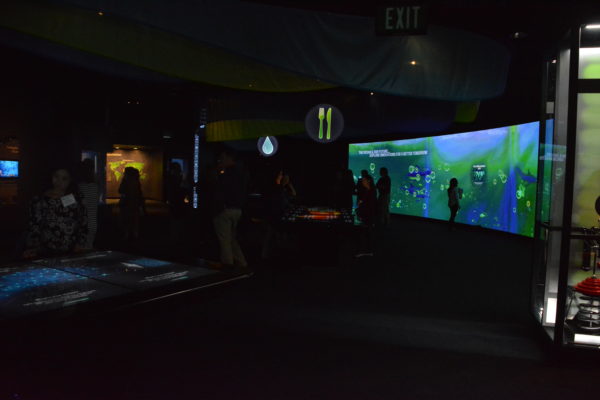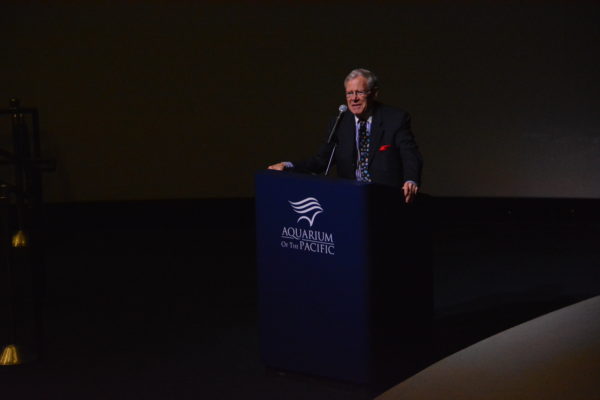by Noella Noelophile®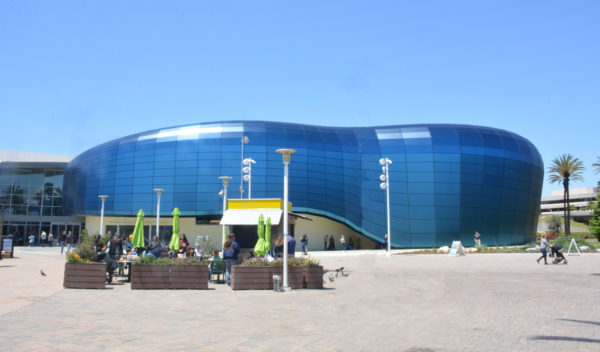
On Thursday afternoon, guests at Long Beach’s Aquarium of the Pacific waded through a “waterfall”.
Schools of fish swam by. Footsteps created ripples. But the guests’ shoes–and the sand-colored carpet–didn’t even get wet.
That’s because the visitors were experiencing a virtual waterfall with digital fish, as they previewed the Aquarium’s brand-new wing, “Pacific Visions”, which opens next Friday, May 24th.
A preview luncheon had included appearances by two special guests.
“Astaire”, the three-year-old penguin, looked ready for his closeup.
“Borrego”, the California desert tortoise, even more so.
“He’s so chill,” one visitor remarked.
“He’s used to lots of schoolchildren around him,” a staffer replied.
“Pacific Visions” includes an art gallery, a state-of-the-art immersive theatre and a culmination gallery with interactive games. And this new 29,000-square-foot structure is designed for education and innovation.
It also represents a landmark move towards a more sustainable future.
“This is the first…major expansion of this Aquarium in its history,” Aquarium President and CEO Dr. Jerry Schubel told a capacity crowd of visitors in the Ocean Theatre. “And it’s been in the works since a retreat of the Aquarium’s Board of Directors in January of 2005.”
Dr. Schubel outlined the main goal of the expansion: conservation.
“It’s not about bigger tanks for bigger animals,” he said. “It’s about the one animal that is putting all the other animals on this planet at risk.”
Referencing the previous week’s U.N. report on extinction, Dr. Schubel told the audience that “we could lose a million species before the end of this century”.
“That’s twelve-and-a-half percent of (all the species on the planet),” he said. “…This is really serious. It isn’t just about feeling good. It’s about the ecosystems that make it.possible for human beings to thrive on this earth.”
“And there’s not a single finding or recommendation, in that (U.N.) report, that is not captured, in some way, in this new wing.”
A city’s support
Long Beach Mayor Robert Garcia and Second District Councilmember Jeannine Pearce took the podium next.
The City of Long Beach, Dr. Schubel told the audience, had made the largest single contribution the Aquarium has received: a fifteen-million-dollar challenge grant towards the creation of the Pacific Visions wing.
“May 24th, for Long Beach, is going to be a very exciting day,” Mayor Garcia said.
“…There is no larger threat to our planet than climate change. And this threat is real, it’s serious, and as we celebrate this opening…it’s incredibly important that we recognize why we’re moving in this direction with this expansion.”
Mayor Garcia referenced the threat of rising sea levels and higher temperatures, to the Long Beach community. The new Pacific Wing, he said, would serve as a research and education facility to address these issues.
“It’s really a place, it’s cutting-edge in discussions and conversations on the future of our planet, and where we fit in, as a region.”
Long Beach Councilmember Jeannine Pearce addressed the timely nature of the new wing’s opening.
“..In the Second District, we have had the pleasure of hosting many events…about climate change, global warming (and) extinction. So it’s good to see (this) room is full, particularly because I know you guys are going to go out and share the fact that we, as a city, have a message.
“That we, as a city, in partnership with the Aquarium, are saying, ‘We recognize there’s a crisis. We recognize that there’s not a second that we can spare, to make sure that we educate and engage, not only Long Beach residents but residents from throughout the region.”
Councilmember Pearce recalled her visits to aquariums during her growing-up years in Texas.
“(That hands-on experience) really instilled in me the idea that we have to fight…for those that…couldn’t fight for themselves…Today we recognize that whenever we pollute, when we put straws out in our beaches and waterways, this is really going to come back and really impact us.”
“I look forward to expanding more, and talking about how…the City of Long Beach can bring science to all of our youth, and to our older adults as well, to make sure we are putting in practice (the skills) that we learned at this very aquarium.”
Today as a legacy
Additional speakers, during the presentation, included San Gabriel and Lower Los Angeles Rivers and Mountains Conservancy Project Manager Marybeth Vergara. San Gabriel and Lower Los Angeles Rivers and Mountains Conservancy invested 1.9 million dollars in the construction of Pacific Visions, according to Dr. Schubel.
“At the Rivers and Mountains Conservancy, our mission is to provide for low-impact recreation, …ecosystem diversity, education and wildlife habitat restoration throughout our Greater Los Angeles region,” Ms. Vergara said.
She stressed the importance, amid climate change, of educating children about our ecosystem.
“There’s a Native American saying that…we’re currently living in our children’s past,” she said.
“And so, what better way for this facility to provide that education to our children and their children’s children. To not only come to learn about the role that the oceans play, in a fragile ecosystem that we must protect, but also, how we can learn about these connections, and how they can create a sustainable future.”
A deep blue concept
And Duncan Ballash, Principal and President of architectural firm EHDD, shared with the audience a little about the process of building “Pacific Visions”. His firm, which designed the original Aquarium building, also created the new wing.
“EHDD started on this journey, of realizing Jerry’s vision for Pacific Visions, over six years ago,” he said. “It’s a very complex project, which involved a lot of challenges for our design team.”
And the resulting concept, he continued, was a metaphor for “the ocean: the deep ocean”.
Projecting the future
“We expect that our attendance will increase by 200,000 a year over its current 1.7 billion (visitors),” Dr. Schubel said.
After the presentation, I asked Mayor Garcia what he loved most, about the innovations in the new Pacific Visions wing. He didn’t hesitate.
“I love that it puts climate change front and center, as the crisis facing the planet and the region,” he said. “I also love that it gives an opportunity for all people that visit the Aquarium, to learn about threats to the planet, and hopefully do something about it.”
A look inside “Pacific Visions”
And the time had come to explore the ways in which Pacific Visions offered that opportunity.
Guests first stepped into the 2,800-square-foot Pacific Visions art gallery.
The gallery’s inaugural installation, “Reefs & Drifters”, includes glass sculptures inspired by plankton and a touchable coral sculpture wall.
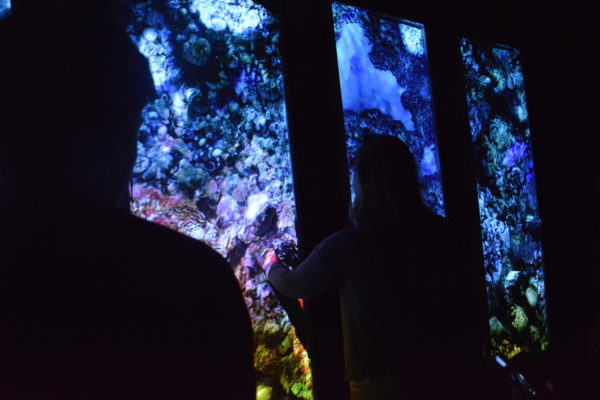 The sculptures demonstrate the shapes and textures of real coral.
The sculptures demonstrate the shapes and textures of real coral.
Meanwhile, on the walls were two- to three-minute video projections, captured by scientists and underwater photographers.
The orientation gallery
Next, the group gathered in the 2,600-square-footorientation gallery”. The virtual waterfall, with its digital fish, had everyone lingering.
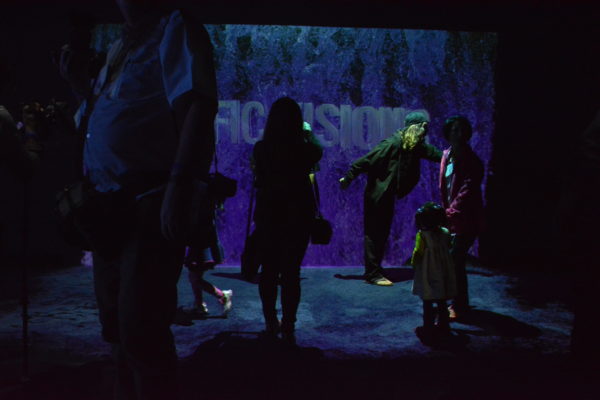 Fish seemed to swim past guests’ shoes, and footsteps seemed to “splash” on the carpet. Guests were captivated–to the point that one Aquarium staffer had to ask everyone to find a seat for the pre-show film.
Fish seemed to swim past guests’ shoes, and footsteps seemed to “splash” on the carpet. Guests were captivated–to the point that one Aquarium staffer had to ask everyone to find a seat for the pre-show film.
“But how will we get our Instagram pictures?” one visitor asked, prompting laughter from the others.
The ten-minute film took visitors through a history of life on Earth and humankind’s connection with water and the sea. After the film’s final challenge, to get involved in designing their futures, guests moved into the 300-seat Honda Pacific Visions Theater.
Showtime – with multisensory effects
Voices lifted in a cappella song greeted them.
The Long Beach Chorale was singing a selection about the ocean and tides. Their performance demonstrated the theater’s excellent acoustics.
Aquarium of the Pacific Board of Directors Vice Chair Doug Otto welcomed the guests, offering a preview of the Honda Pacific Visions Theater’s upcoming programming.
“This space will be used, not only as part of our regular visitor experience but also as a venue, for live music, dance, theatre, community meetings, lectures and other special events, here at the Aquarium,” he said.
And “spectacular” may be an understatement, to describe the theater.
The 130-foot-long curved screen is designed to take in all of viewers’ peripheral vision. The 36-foot-wide disc floor projection can lift up, Mr. Otto said, and “we also have technology to create multisensory experiences, such as wind, fog and vibrating seats.”
A few minutes later, the audience had the opportunity to experience some of those effects. During the showing of a short “Pacific Visions” film, a whale was shown “breaching” from the ocean–and viewers’ seats shook slightly from the impact as he landed. As a thunderstorm crackled onscreen, winds blew across visitors’ faces.
That technology, along with the features in the next room, was created by interactive media design firm Cortina Productions. But they didn’t stop at special effects.
“(We created) something quite new: ultra-haptics,” said Cortina Productions President and Creative Director Joseph Cortina.
“For both our sound-challenged and vision-challenged (visitors, these) will create shapes and textures in midair, using ultrasound.”
A culmination
The final Pacific Visions stop of the day was in the culmination gallery, where guests had free time to explore.
This room presented a sobering challenge: world population, expected to grow to ten billion by the year 2050.
Guests could explore means of interacting with the ecosystem to ensure sufficient resources to support the burgeoning population.
This 50-foot interactive “touch wall” allowed guests to make a motion near an icon. Sensors would then “pop the bubble” and show ways of reducing our carbon footprint.
“It’s updatable, so the Aquarium of the Pacific can add new content…so it can stay up to date,” Mr. Cortina said.
“There’s a lot of things for people to do (in the culmination room), and really start to hone in on…things you can do yourself, on a day-to day basis, to really help the environment.”
One such activity was the “game” on this interactive consoles, in the center of the room. It showed guests’ level of sustainability in food consumption and water conservation, then let them “vote”, as a team of four, on future collective actions to take, to protect the environment.
This display allowed guests to travel through the a future metropolis which included seawalls against rising ocean levels and vertical agriculture to provide sufficient food.
Denizens of the water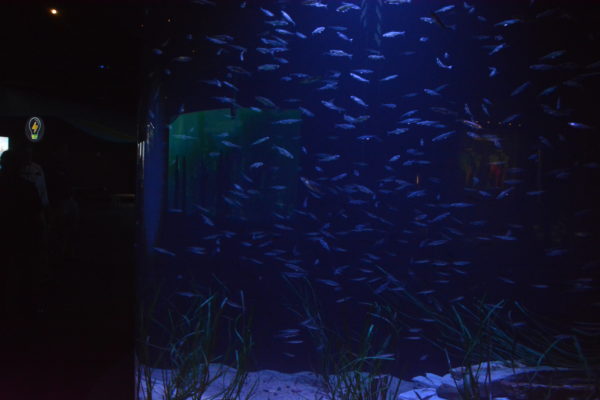
And the gallery exhibit featured three species that are related to the story of energy and water.
The Delta smelt, as Aquarium Vice President of Animal Husbandry Dr. Sandy Trautwein explained, is found only in the Sacramento and San Joaquin river delta. Delta smelt, as a species, are very near extinction due to destruction of their natural habitat.
“With a school of about 500,…the Aquarium is very proud to be the first and only aquarium publicly displaying Delta smelt,” Dr. Trautwein said.
A second species on exhibit was the California yellowtail. The yellowtail, Dr. Trautwein explained, is an example of a fish that could be sustainably farmed off the Southern California coast.
“By shifting some of our resources from those items with high environmental impact, like beef or pork, to those with lower impact, like fish, the United States can develop a more environmentally-responsible food supply.”
And the Pacific and Olympia oysters, she added, are to illustrate the benefits of developing more oyster farms off our coast.
“You see, oysters filter sediment and other pollutants out of the water at a rate of about fifty gallons per day. Plus, oyster beds help to sustain our shorelines and protect them against high tides and rising sea level, and to provide a habitat for other marine life.”
The Aquarium’s new Pacific Visions wing had already offered lots of new information on our planet, oceans and future–and its official opening was still a week away!
But its message of conservation and experimentation to create new ways to protect our fragile ecosystem, was loud and clear.
“This is the most important story that we’ve had, in the history of human beings,” Dr. Schubel said to the gathered members of the media, in his closing remarks.
“…If there’s a hero in this story, it will be all of us. It took billions of people to get us into the fix we’re in today, and it’s going to take billions of people to get us out of it.
“But we have the choice of creating a glorious future. And the decisions that we make, over the next few decades, will determine what kind of a future our children and grandchildren will live. ”

